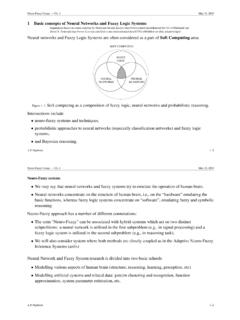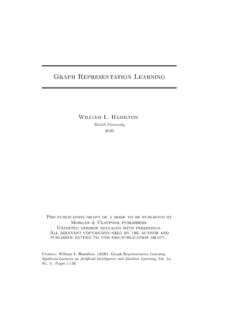Transcription of 1 Basic concepts of Neural Networks and Fuzzy Logic ...
1 Neuro- Fuzzy Comp. Ch. 1 May 25, 20051 Basic concepts of Neural Networks and Fuzzy Logic SystemsInspirations based on course material by Professors Heikki Koiovo andDavid S. Touretzki are duly acknowledgedNeural Networks and Fuzzy Logic Systems are often considered as a part ofSoft Computingarea:115 Chapter 8 ConclusionFigure Soft computing as a union of Fuzzy Logic , Neural Networks and probabilistic include neurofuzzy techniques, probabilistic view on Neural Networks (especiallyclassification Networks ) and similar structures of Fuzzy Logic systems and Bayesian strengthnesses of each methods are summarized in the following table: COMPUTINGF igure 1 1:Soft computing as a composition of Fuzzy Logic , Neural Networks and probabilistic include neuro- Fuzzy systems and techniques, probabilistic approaches to Neural Networks (especially classification Networks ) and Fuzzy logicsystems, and Bayesian Papli nski1 1 Neuro- Fuzzy Comp.
2 Ch. 1 May 25, 2005 Neuro- Fuzzy systems We may say that Neural Networks and Fuzzy systems try to emulate the operation of human brain. Neural Networks concentrate on the structure of human brain, , on the hardware emulating thebasic functions, whereas Fuzzy Logic systems concentrate on software , emulating Fuzzy and approach has a number of different connotations: The term Neuro- Fuzzy can be associated with hybrid systems which act on two distinctsubproblems: a Neural network is utilized in the first subproblem ( , in signal processing) and afuzzy Logic system is utilized in the second subproblem ( , in reasoning task). We will also consider system where both methods are closely coupled as in the Adaptive Neuro-FuzzyInference Systems (anfis) Neural network and Fuzzy System research is divided into two Basic schools Modelling various aspects of human brain (structure, reasoning, learning, perception, etc) Modelling artificial systems and related data: pattern clustering and recognition, functionapproximation, system parameter estimation, Papli nski1 2 Neuro- Fuzzy Comp.
3 Ch. 1 May 25, 2005 Neural network research in particular can be divided into Computational Neuroscience Understanding and modelling operations of single neurons or small neuronal circuits, Modelling information processing in actual brain systems, auditory tract. Modelling human perception and cognition. Artificial Neural Networks used in Pattern recognition adaptive control time series prediction, contributing to Artificial Neural Networks : Statistical Pattern recognition Computational Learning Theory Computational Neuroscience Dynamical systems theory Nonlinear Papli nski1 3 Neuro- Fuzzy Comp. Ch. 1 May 25, 2005We can say that in general Neural Networks and Fuzzy Logic systems are parameterised computational nonlinear algorithms fornumerical processing of data (signals, images, stimuli).
4 These algorithms can be either implemented of a general-purpose computer or built into a dedicatedhardware. Knowledge is acquired by the network /system through a learning process. The acquired knowledge is stored in internal parameters (weights).(Parameters)UnknownSystemNeura l network / Fuzzy Systemcontrol signalsdataEssential aspects of data, orparameters of the unknown system modelFigure 1 2:System as a data Papli nski1 4 Neuro- Fuzzy Comp. Ch. 1 May 25, Biological Fundamentalsof Neural NetworksA typical neuron, or nervecell, has the followingstructure:from Kandel, Schwartz and Jessel,Principles of Neural Science Most neurons in the vertebrate nervous system have several main featuresin common. Thecell bodycontains the nucleus, the storehouse of genetic information,and gives rise to two types of cell processes,axonsanddendrites.
5 Axons, the transmitting element of neurons, can vary greatly in length;some can extend more than 3m within the body. Most axons in the centralnervous system are very thin ( .. 20 m in diameter) compared withthe diameter of the cell body (50 m or more). Many axons are insulated by a fatty sheath of myelin that is interrupted atregular intervals by the nodes of Ranvier. Theaction potential, the cell s conducting signal, is initiated either at theaxon hillock, the initial segment of the axon, or in some cases slightlyfarther down the axon at the first nod of Ranvier. Branches of the axon of one neuron (the presynaptic neuron) transmitsignals to another neuron (the postsynaptic cell) at a site called thesynapse. The branches of a single axon may form synapses with as many as 1000other neurons.
6 Whereas the axon is the output element of the neuron, thedendrites(apical and basal) are input elements of the neuron. Together with the cellbody, they receive synaptic contacts from other Papli nski1 5 Neuro- Fuzzy Comp. Ch. 1 May 25, 2005 Simplified functions of these very complex in their nature building blocks of a neuron are as follow: The synapses are elementary signal processing devices. A synapse is a biochemical device which converts a pre-synaptic electrical signal into a chemicalsignal and then back into a post-synaptic electrical signal. The input pulse train has its amplitude modified by parameters stored in the synapse. The nature ofthis modification depends on the type of the synapse, which can be either inhibitory or excitatory.
7 The postsynaptic signals are aggregated and transferred along the dendrites to the nerve cell body. The cell body generates the output neuronal signal, activation potential, which is transferred along theaxon to the synaptic terminals of other neurons. The frequency of firing of a neuron is proportional to the total synaptic activities and is controlled bythe synaptic parameters (weights). The pyramidal cell can receive104synaptic inputs and it can fan-out the output signal to thousands oftarget cells the connectivity difficult to achieve in the artificial Neural Papli nski1 6 Neuro- Fuzzy Comp. Ch. 1 May 25, 2005 Another microscopic view of typical neuron of the mammalian cortex (a pyramidal cell): Note the cell body or soma, dendrites, synapsesand the axon.
8 Neuro-transmitters (information-carryingchemicals) are released pre-synaptically, floatsacross the synaptic cleft, and activate receptorspostsynaptically. According to Calaj s neuron-doctrine information carrying signals come into thedendrites through synapses, travel to the cellbody, and activate the axon. Axonal signals arethen supplied to synapses of other 20020406080100120time [msec]Action potential [mV]Injected current and action Papli nski1 7 Neuro- Fuzzy Comp. Ch. 1 May 25, A simplistic model of a biological neurontxitDendriteAxonSynapsesPost synaptic signalAxon HillockCell Body (Soma)Activation potentialOutput Signal, jxyInput Signals, yjFigure 1 3:Conceptual structure of a biological neuronBasic characteristics of a biological neuron: data is coded in a form of instantaneous frequency of pulses synapses are either excitatory or inhibitory Signals are aggregated ( summed ) when travel along dendritic trees The cell body (neuron output) generates the output pulse train of an average frequency proportional tothe total (aggregated) post-synaptic activity (activation potential).
9 Papli nski1 8 Neuro- Fuzzy Comp. Ch. 1 May 25, 2005 Levels of organization of the nervous systemfrom ,Fundamentals of Computational Neuroscience, Oxford University Press, Papli nski1 9 Neuro- Fuzzy Comp. Ch. 1 May 25, 2005A few good words about the brainAdapted from S. Haykin, Neural Networks a Comprehensive Foundation,Prentice Hall, 2nd ed., 1999 The brain is a highly complex, non-linear, parallel information processing system. It performs tasks likepattern recognition, perception, motor control, many times faster than the fastest digital computers. Biological neurons, the Basic building blocks of the brain, are slower than silicon Logic gates. Theneurons operate in milliseconds which is about six seven orders of magnitude slower that the silicongates operating in the sub-nanosecond range.
10 The brain makes up for the slow rate of operation with two factors: a huge number of nerve cells (neurons) and interconnections between them. The number ofneurons is estimated to be in the range of1010with60 1012synapses (interconnections). A function of a biological neuron seems to be much more complex than that of a Logic gate. The brain is very energy efficient. It consumes only about10 16joules per operation per second,comparing with10 6J/oper sec for a digital plasticity: At the early stage of the human brain development (the first two years from birth) about 1 millionsynapses (hard-wired connections) are formed per second. Synapses are then modified through the learning process (plasticity of a neuron). In an adult brain plasticity may be accounted for by the above two mechanisms: creation of newsynaptic connections between neurons, and modification of existing Papli nski1 10 Neuro- Fuzzy Comp.





![A arXiv:2005.04966v5 [cs.CV] 30 Mar 2021](/cache/preview/a/a/c/e/1/8/e/e/thumb-aace18ee207668ebc3cd4c4d68b557da.jpg)
